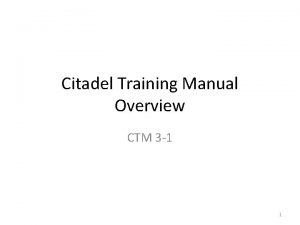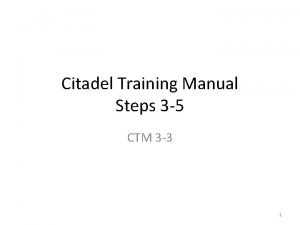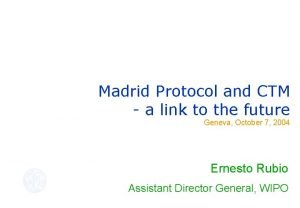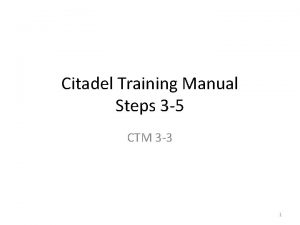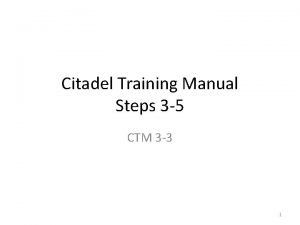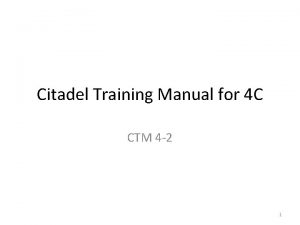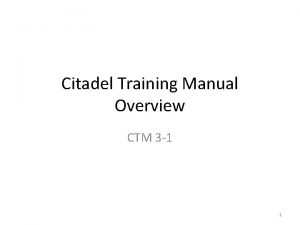Citadel Training Manual Steps 3 5 CTM 3














- Slides: 14

Citadel Training Manual Steps 3 -5 CTM 3 -3 1

Training Objective • Task: Understand Steps 3 -5 of the Citadel Training Method with a particular emphasis on how it impacts you as a thirdclass cadet • Condition: Given the Citadel Training Manual and having already had an introductory overview LTP on CTM and an LTP on Steps 1 -2 • Standard: As part of a group, correctly apply Steps 3 -5 of CTM to a thirdclass-specific scenario 2

Review: 5 Steps of CTM • Set expectations • Build basic skills • Give feedback – INPUT+ • Follow through with consequences – PRIDE These three are the subject for today • Work for growth in others 3

Step 3: Feedback • “Give feedback” is the third step in the five-step CTM process – Leaders and subordinates exchange information about the progress of training and development, and the performance of duties in order to improve weaknesses and sustain strengths • Uses “INPUT+” – Immediate; No name calling; Proper person; Uniquely specific; Talk behavior; End positively 4

Step 3: Feedback • Immediate (On the spot or as soon as possible rather than days, weeks, or months later) • No name calling (“Cadet Jones” or “Fred” instead of “Yo, dirtbag”) • Proper person (What are the pros and cons of group punishment or group reward? Under what circumstances are these effective or ineffective? ) • Uniquely specific (“Swing your arms nine to the front and six to the rear” rather than “You suck at marching”) • Talk behavior (Focus on behavior, not the person… “We need to get your arm swing right” rather than “You’re a terrible knob”) • End positively (This increases the chances that the subordinate will have a positive attitude to the feedback) 5

Practical Exercise #1: Feedback • Divide up into the number of groups designated by the TAC • Appoint a group leader, recorder, time keeper, spokesman, and devil’s advocate • Take five minutes to develop how you can provide positive feedback to a 4 C in your squad who ends the first semester with a 1. 6 GPA and an F in Spanish and a D in History – – – Immediate No name calling Proper person Uniquely specific Talk behavior End positively • Be prepared to report your results to the class 6

Step 4: Consequences • Add action to the words expressed in the Feedback step • Use “PRIDE” – Progressive (Start with small rewards or punishments to allow “room” for more drastic consequences in the future) – Relevant (Must be meaningful to the subordinate) – Immediate (Close time proximity helps tie the behavior to the consequence) – Directed at behavior (Same as with Feedback… tie consequences to the behavior, not the person) – Even handed (Be consistent… avoid emotion, bias, and favoritism) 7

Step 4: Consequences • Which step of PRIDE (Progressive, Relevant, Immediate, Directed at behavior; Even handed) is represented in these examples, and is it a good or bad example? • A cadet has a gross room today and gets his PR two weeks later. • A knob is late formation and has to do push-ups. A sophomore is late for the same formation and no one says anything. • A cadet with Gold Stars or on the Dean’s List is authorized a Charleston Pass until 2230 on Wednesday. • The first time a cadet’s shoes are improperly shined, his squad leader gives him a verbal counselling. The second time, she writes a PR. • A cadet fails his CPFT and is then placed on remedial PT. • A cadet who is a good 4 C is made a CPL as a 3 C. She does a good job as a CPL and is made a drillmaster as a 2 C. She does a good job as drillmaster and is made battalion ops officer as a 1 C. 8

Step 5: Growth • “Work for growth in others” is Step 5 of CTM • Motivates followers to: – Require less supervision – Exceed expectations – Raise their level of consciousness about the importance of goals and values – Transcend their own self-interest for the sake of the organization – Move to address higher level needs – Prepare for additional responsibilities and challenges 9

Step 5: Growth • Leaders can encourage subordinates to grow by: – Creating an optimistic organizational climate – Helping them build resiliency • The elasticity, durability, and adaptability that make it possible to recover quickly from change, hardship, or misfortune • It allows growth from disappointment as well as from success – Promoting the self-confidence that helps people overcome the fear of failure and take action – Promoting the high self-esteem that provides resistance, strength, and a capacity for regeneration 10

Step 5: Growth • Actions that increase self-esteem – Providing positive feedback – Praising in public – Succeeding – Focusing on strengths – Developing a niche – Giving your support • Actions that decrease self-esteem – Making a poor comparison to peers – Failing – Putting a subordinate in a no-win situation – Name calling – Creating a crisis of competence – Ridiculing in public 11

Step 5: Growth • As subordinates grow, leaders give them: – Greater initiative using “mission orders” that emphasize to subordinates the results to be attained, but not how they are to achieve them – New challenges and responsibilities that in effect inaugurate a new iteration of the CTM cycle – Mentoring that occurs over a substantive period of time on a personal level 12

Open Discussion • What are positive or negative examples of the feedback, consequences, growth sequence you have experienced as a cadet or some other time? • What leadership lessons did you learn from that experience? Feedback Consequences Growth 13

Conclusion • Any ideas for improving this class? • Sophomores have one more CTM LTP which is an individual exercise that will require you to provide written responses to some questions about CTM 14
